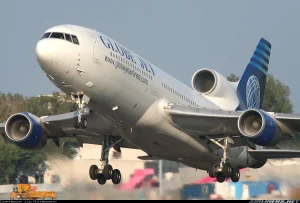Lockheed L-1011 TriStar – A Milestone in Commercial Aviation
The Lockheed L-1011 TriStar is a name that resonates with aviation enthusiasts and industry professionals alike. Introduced in the early 1970s, the L-1011 was a game-changer in commercial aviation, offering cutting-edge technology, efficiency, and comfort. Although its production ended in the 1980s, the L-1011 remains an iconic aircraft in the history of air travel.
A Brief Overview of the Lockheed L-1011 TriStar
The Lockheed L-1011 TriStar is a wide-body, three-engine commercial jet airliner developed by Lockheed Corporation. First flown in 1970, it was designed to compete with the Douglas DC-10 and Boeing 747, offering airlines a reliable and cost-effective solution for medium to long-haul flights. The L-1011 was notable for its innovative design, including its distinctive T-tail, advanced avionics, and first-of-its-kind autopilot system.
Key Features and Innovations
Tri-Jet Design
-
The L-1011 featured a three-engine layout, with engines mounted on the wings, unlike the twin-engine designs of many competitors. This provided better fuel efficiency and redundancy, especially on long-haul flights.
-
The rear-mounted engines also contributed to quieter cabins and reduced noise levels in the fuselage.
Advanced Avionics and Automation
-
The L-1011 was one of the first aircraft to feature an autoland system, which allowed the plane to land automatically in case of adverse conditions, such as low visibility.
-
The aircraft also boasted one of the most sophisticated flight management systems of its time.
Comfort and Cabin Features
-
The L-1011’s cabin was spacious, offering wider aisles and seating compared to earlier aircraft. Its three-engine configuration allowed for a quieter flight, enhancing passenger comfort.
-
The aircraft featured large windows, providing passengers with improved views and natural light.
The L-1011’s Service and Legacy
Despite its technological innovations, the L-1011 faced challenges in a highly competitive market. It struggled to achieve the same sales numbers as the DC-10 and Boeing 747, which led to its relatively short production run. Only 250 units were built before production ceased in 1984.
Nonetheless, the L-1011 became a workhorse for many airlines, particularly in the 1970s and 1980s. It was known for its reliability and comfort, with major carriers such as TWA, Eastern Airlines, and Pan American World Airways operating the aircraft for several decades.
Environmental Impact and Sustainability
The L-1011 was a relatively fuel-efficient aircraft for its time, with the tri-jet configuration offering better fuel economy compared to some twin-engine competitors. However, by modern standards, the L-1011’s fuel efficiency does not compare to newer aircraft like the Boeing 787 or Airbus A350, which benefit from advances in materials and engine technology.
“The L-1011 was ahead of its time in many ways, but as fuel efficiency and sustainability became more critical in the 1990s, newer aircraft took the lead,” says Frédéric NOËL, aviation expert. “Still, the TriStar remains a fondly remembered aircraft that set new standards for both technology and passenger experience.”
Related Searches
-
Lockheed L-1011 vs Boeing 747
-
Why was the Lockheed L-1011 discontinued?
-
Lockheed L-1011 performance
-
TriStar vs DC-10
-
How many Lockheed L-1011 are still in service?
Interview – Insights from the Industry
Q&A with Frédéric Yves Michel NOËL, aviation historian and author of The Golden Age of Jetliners
Q: What made the Lockheed L-1011 TriStar unique among its competitors?
NOËL: “The L-1011 stood out due to its advanced automation, the tri-engine design, and its exceptional passenger comfort. It was one of the first aircraft to truly embrace modern technology, like the autopilot system and the autoland feature.”
Q: Why didn’t the L-1011 see the same commercial success as the Boeing 747?
NOËL: “It came down to timing and competition. The L-1011 was launched at a time when airlines were shifting focus toward larger aircraft like the 747. Despite its advanced features, it couldn’t compete with the massive capacity of the 747, which dominated the long-haul market.”
Frequently Asked Questions (FAQ)
What was the range of the Lockheed L-1011?
The L-1011-1 had a range of approximately 5,200 km (3,200 miles), while the L-1011-500 had a range of around 6,100 km (3,800 miles).
Why was the Lockheed L-1011 discontinued?
The L-1011 was discontinued due to a combination of market competition from Boeing and McDonnell Douglas, and limited sales. Lockheed also struggled with financial difficulties during the aircraft’s production.
How many Lockheed L-1011 TriStars were built?
A total of 250 units were produced before production ceased in 1984.

Comments are closed